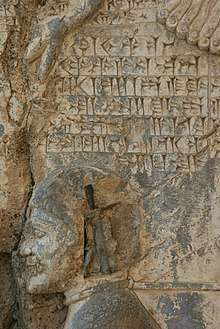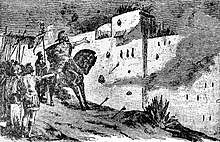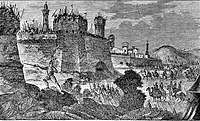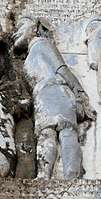Nebuchadnezzar III
Nebuchadnezzar III or Nebuchadrezzar III[lower-alpha 1] ruled over Babylon (c. 522 BC). He claimed to be the second son of Nabonidus.

He led a short-lived rebellion against Darius the Great, who routed his army in battle at the Tigris on December 13, 522 BC, and then at the Euphrates near Zazannu.[3] Nebuchadnezzar III fled back to his capital with his remaining cavalry.[4]
Darius subsequently besieged the high-walled city of Babylon, succeeding in taking the capital, and Nebuchadnezzar III was put to death.[4]
His exact identity is uncertain. According to the Behistun Inscription, Darius claimed that he was an impostor called Nidinta-Bel, but some historians consider that he probably did have some connection with the previous Babylonian royal family.
He should not be confused with Nebuchadnezzar IV, who led a similar revolt against the Persians around a year later.
 The Babylonians deriding Darius in 522 BC.
The Babylonians deriding Darius in 522 BC. The Babylonians in their city deriding Darius.
The Babylonians in their city deriding Darius. Behistun relief, Nidintu-Bel in chains.
Behistun relief, Nidintu-Bel in chains.
Notes
- "In some passages of the Bible, the name is given, mistakenly, with an "n" in place of the "r," as Nebuchadnezzar."[2]
References
- Behistun, minor inscriptions DBb inscription- Livius.
- Asimov, I. (1968) The Near East, Boston: Houghton Mifflin Co., p. 62
- Harvard University; G. P. Goold (1 January 1972). Harvard Studies in Classical Philology. Harvard University Press. pp. 112–. ISBN 978-0-674-37922-0. Retrieved 19 March 2012.
- Tom Holland (12 June 2007). Persian Fire: The First World Empire and the Battle for the West. Random House Digital, Inc. pp. 46–. ISBN 978-0-307-27948-4. Retrieved 19 March 2012.
| Preceded by Nabonidus |
King of Babylon 522 BC |
Succeeded by Nebuchadnezzar IV (Self-proclaimed) |